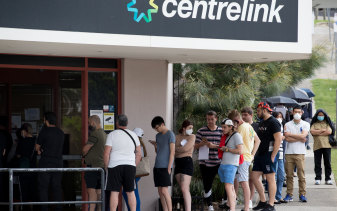Morrison’s JobSeeker boost is stingy, mean and bad for the economy
I’m powering my home and eating for free thanks to COVID-19. I discovered this remarkable factoid after running the sums on the effect of recent tax cuts and interest rate reductions on my household budget.
As a high-income-earning mortgage holder, my windfall has been twofold. First, last year’s tax cuts have delivered a boost to my take-home pay of about $93 a fortnight, or $6.66 a day. Meanwhile, the interest rate payable on my $700,000 (ish) mortgage has fallen from 2.69 per cent to about 2.13 per cent (thanks also to some savvy shopping around). This boosts my bottom line by about $150 a fortnight, or $10.74 a day.

All up, I’m $17.45 a day ahead – about $530 a month – thanks to the government and Reserve Bank’s COVID-inspired support measures. I usually spend about $350 to $400 dollars a month on food and just over $100 on my power bill.
Exactly why I, as a highly educated media professional, should have been targeted by the government and policymakers in this way remains something of a mystery to me, particularly at a time when they’re working feverishly to shake down global tech giants to pay a portion of my salary. Thanks, fellas!
Now contrast this, of course, to the generosity shown to JobSeeker recipients, who learnt this week they will receive a $50-a-fortnight continuing boost to their payments after more generous coronavirus supplements expire at the end of next month. They’ll pocket an extra $3.57 a day – about one-fifth of the benefit I’ve seen.
Some have dismissed the sum as little more than a daily cup of coffee. But, of course, welfare recipients rarely have enough spare change for such barista-made treats. That $3.50 can, however, cover one or two meals a day. Or the internet and phone bill for the month. Or car rego and insurance for the year. It’s not nothing. But it’s a pittance compared with what I have received and falls well short of what business groups, economists and social service groups had been calling for.

True, it is the first real increase to Australia’s jobless payment since before the last recession. But that’s not saying much. Since the days of the Howard government, jobless payments have been set to rise only in line with consumer price increases each year, not wages. Because wages growth usually outstrips growth in prices, this means jobless support has shrunk relative to both wages and pensions (which are, by contrast, indexed to wages).
Brendan Coates and Matt Cowgill at the Grattan Institute have run the numbers. Even after the boost, they estimate that “Australia will have the second-stingiest payment for newly-unemployed people out of all 37 members of the OECD, behind only Greece”.
“An Australian on an average wage who loses their job will find that JobSeeker and Commonwealth Rent Assistance combined add up to only a bit more than a quarter – 27 per cent – of what they earned when they were working,” Coates and Cowgill estimate. “An unemployed Canadian would get 62 per cent of the average wage. The average across the rich countries is 58 per cent, about double Australia’s new payment.”
Now, it’s true that many countries set their jobless payments relatively high initially but shrink them over time, to further induce people back to work. We’re just stingy from the outset. And our stinginess will only get stingier with time, due to the government’s inaction on revising indexation arrangements. As a result of this week’s decision, JobSeeker will continue to rise only with consumer prices, meaning recipients will fall further behind as wages pick up.
As things stand, JobSeekers are set to receive just 41 per cent of the full-time minimum wage and 66 per cent of the aged pension. For the more than a million Australians on JobSeeker today, they will continue to face difficult trade-offs, like foregoing medications or travel – the very things essential to their continued ability to search for and secure work.
On the upside, they will be able to earn slightly more side income – up to $150 a fortnight – before their benefits are withdrawn.
Now, the government is right to argue JobSeeker payments should not act as a replacement wage, but rather a “safety net”. The tricky thing about safety nets, however, is they have to be slung sufficiently high off the ground to ensure you don’t accidentally hit rock bottom when you fall.
On the reckoning of economists and many others, even after this boost, our jobless payment does not do that. Which is a shame not just from a moral viewpoint, but an economic one too. The thing about giving money to those who have very little of it is that they are more likely to actually spend it. That money circulates back into the economy, driving jobs and growth. For me, the government’s largesse is just helping me to pay down my home loan faster.
The Morrison government had been doing admirably to put ideology aside to guide us through this economic and health crisis. It has fallen woefully short at the last hurdle. Its decision on JobSeeker is stingy and mean. People will suffer needlessly because of it. And so, too, will our economy.
Jessica Irvine is a senior economics writer with The Sydney Morning Herald.
Most Viewed in Business
Source: Thanks smh.com